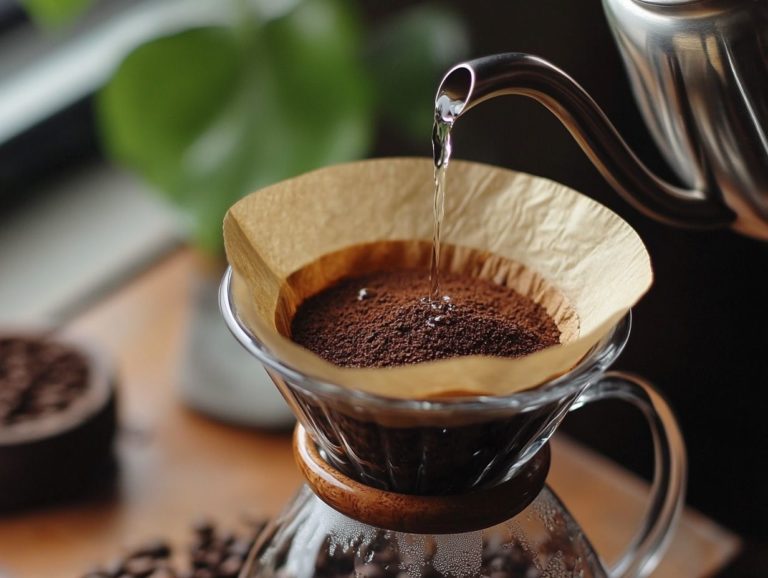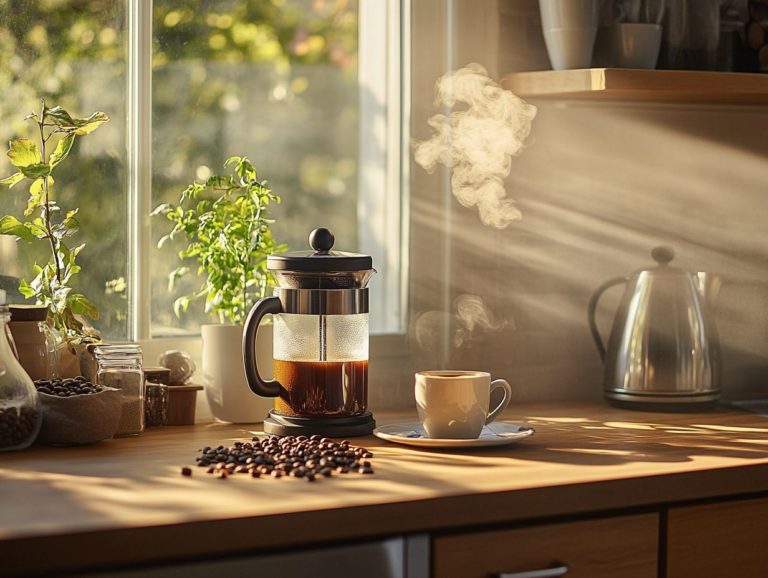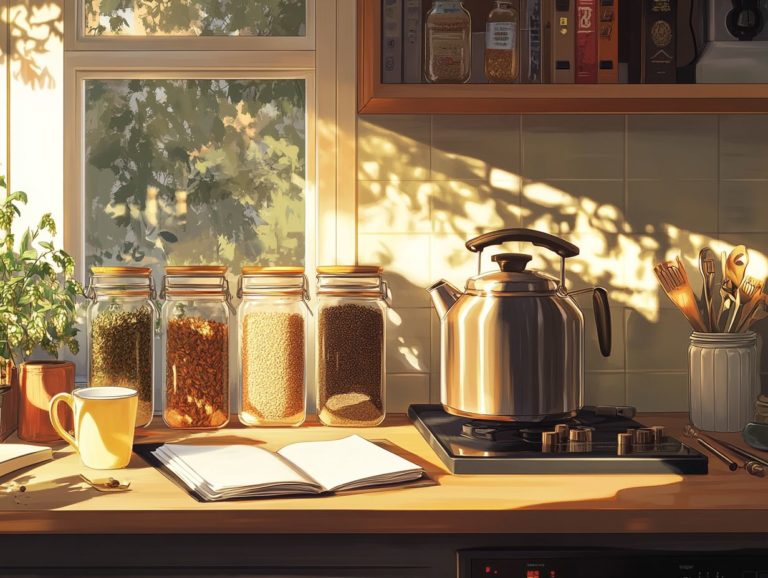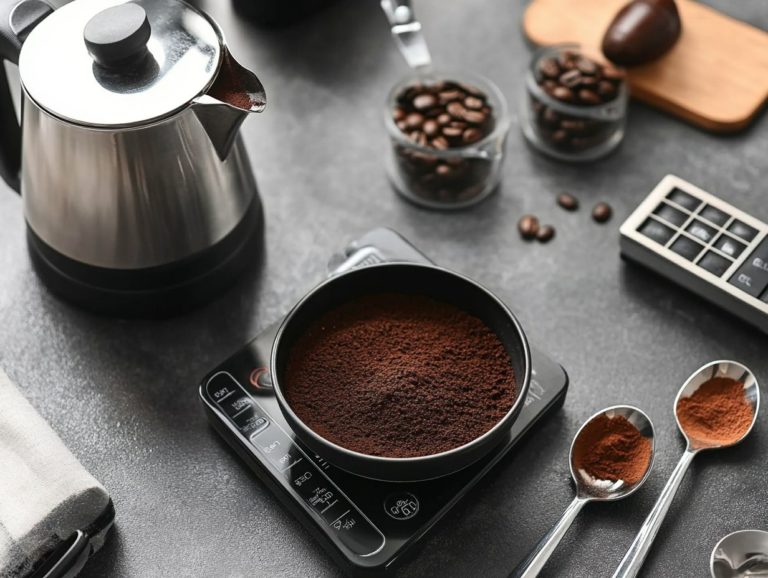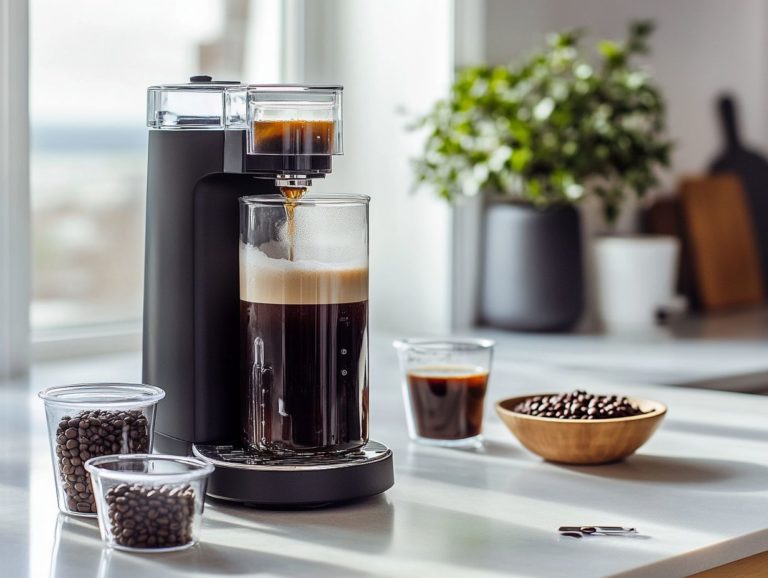Expert Tips for Brewing Coffee in a French Press
If you re seeking to elevate your coffee experience, the French press may very well become your new best companion. This timeless coffee brewing method delivers a richer and more robust cup of coffee. It also embodies a delightful simplicity that appeals to coffee lovers.
In this guide, you will discover what sets French press coffee apart from other brewing techniques. You’ll learn about the many benefits of this method and the secrets to achieving the perfect brew. From choosing the finest coffee beans to mastering the brewing process, you ll uncover valuable tips to enhance your coffee ritual.
So, seize your French press and immerse yourself in the joy of brewing coffee!
Contents
- Key Takeaways:
- What is a French Press?
- What Makes French Press Coffee Different?
- What Are the Benefits of Using a French Press?
- Discover the Benefits of Using a French Press
- What Type of Coffee Beans Should You Use for French Press?
- 1. Dark Roast vs Light Roast
- 2. Whole Beans vs Ground Beans
- How to Brew Coffee in a French Press
- 2. Measure and Grind Your Coffee Beans
- 3. Add Hot Water and Let It Bloom
- 4. Stir and Let It Steep
- 5. Press and Pour
- Tips for Getting the Best Cup of French Press Coffee
- Essential Tips for Brewing French Press Coffee
- 1. Use Freshly Roasted Beans
- 2. Experiment with Ratios and Brewing Time
- 3. Don’t Press Too Hard
- 4. Clean Your French Press Properly
- Frequently Asked Questions for French Press Techniques
- 1. Can I use any type of coffee beans in a French press for brewing coffee?
- 2. How long should I let the coffee steep in a French press for optimal brewing?
- 3. Do I need to preheat my French press before brewing for better coffee preparation?
- 4. How much coffee should I use in a French press for the best coffee?
- 5. Can I make cold brew in a French press as an alternative brewing method?
- 6. How do I clean a French press using proper coffee tools?
Key Takeaways:

- French press coffee is stronger and more flavorful than other brewing methods.
- Using freshly roasted whole beans and experimenting with brewing ratios and the time it takes to brew coffee can result in the best cup of French press coffee.
- Cleaning your French press properly and not pressing too hard can help maintain the integrity of your coffee’s flavor and quality.
What is a French Press?
A French press, often referred to as a press pot or plunger pot, is not just a coffee brewing device; it s your gateway to crafting a rich and flavorful cup of coffee. This elegant method employs a mesh filter alongside a sleek cylindrical glass or stainless steel container. It allows you to steep coffee grounds in hot water, beautifully extracting the full spectrum of flavors and aromas from the coffee beans.
This process gives your brew a depth that s hard to replicate and elevates your coffee experience. The French press has become a favorite among coffee lovers, thanks to its full immersion brewing experience, which many cherish for its unique qualities.
You ll find various options available, such as the Bodum Chambord and the Espro French Press, each bringing its own distinctive touch to your coffee ritual. Dive into the world of rich flavors and aromatic delights with your French press!
What Makes French Press Coffee Different?
French press coffee distinguishes itself from other brewing methods through its unique full immersion technique. This technique allows the coffee grounds to steep directly in hot water, resulting in a rich and robust cup of coffee that captivates the senses and elevates the flavor.
Unlike filter coffee methods that rely on paper filters, the French press employs a mesh filter. This permits more oils and fine particles to pass through, enriching the coffee’s body and flavor profile. This method emphasizes the coffee extraction process and optimizes the coffee-to-water ratio, enhancing your overall coffee experience.
What Are the Benefits of Using a French Press?
Using a French press to brew your coffee offers many benefits that enhance the experience for both coffee enthusiasts and casual drinkers. For starters, it grants you precise control over key brewing variables like grind size, brew time, and coffee-to-water ratios elements that can dramatically influence the flavor and overall satisfaction of your cup.
The French press also eliminates the need for paper filters. This makes it an eco-friendly choice that allows the natural oils and flavors to shine through in your brew. Its simplicity and effectiveness make it a beloved method for those who crave a rich, full-bodied cup of coffee while being environmentally conscious.
Discover the Benefits of Using a French Press
Using a French press is a wonderful way to enhance your coffee experience. In this article, we will explore the various advantages of brewing coffee with a French press, from the rich flavor it provides to its eco-friendly benefits.
1. Stronger and More Flavorful Coffee
One of the primary advantages of using a French press is that it creates a coffee experience that is both stronger and more flavorful than other brewing methods. This makes it a popular choice among coffee enthusiasts.
This exceptional quality comes from how coffee is brewed, where coffee grounds steep in hot water for about four minutes. During this time, essential oils and fine coffee particles are released, enriching the flavor profile and elevating your cup to new heights, much like an espresso.
The coarser grind size used in a French press plays a crucial role in retaining these oils, as they are less likely to become trapped in a filter. Factors such as water temperature, steeping time, and the coffee-to-water ratio significantly impact the strength and enjoyment of your brew. By experimenting with these variables, you can customize your cup to achieve the perfect balance of acidity and body, allowing the coffee’s inherent character to shine through and enhance your enjoyment.
2. No Need for Filters
Unlike traditional coffee brewing methods that rely on paper filters, the French press uses a mesh filter, freeing you from disposable materials. This simple design streamlines the brewing process and significantly enhances your eco-friendly practices.
By choosing a French press, you can greatly reduce your carbon footprint associated with the production and disposal of paper filters. The mesh filter allows the rich oils and fine particles from the coffee grounds to infuse into your brew, resulting in a fuller flavor profile while being kind to the environment.
Its durability means you can reuse the mesh filter countless times, supporting a sustainable lifestyle while minimizing landfill waste. In essence, switching to a French press aligns your coffee habits with your commitment to environmentally conscious choices.
3. Easy to Use and Clean
The French press is a gem in the coffee world, known for its elegant simplicity that appeals to both budding aficionados and seasoned drinkers. Its straightforward design makes it a breeze to use and clean.
Brewing with a French press is delightfully easy. With just a few simple steps, you can achieve that rich, full-bodied cup you crave, making it an ideal addition to any coffee lover’s toolkit.
- Start by coarsely grinding fresh coffee beans; a Burr Grinder is your best bet for consistency.
- Measure about 1 to 2 tablespoons of coffee for every six ounces of hot water.
- Add the coffee grounds to the French press, pour in the hot water (just off the boil), and stir gently.
- Let it steep for roughly four minutes, then slowly press down the plunger to separate the grounds from your liquid gold.
- Finally, pour your freshly brewed coffee into your favorite mug and enjoy every sip.
Cleaning is just as straightforward. Simply disassemble the French press, rinse the components under warm water, and you re ready for your next brewing adventure. This makes enjoying great coffee easy and exciting!
What Type of Coffee Beans Should You Use for French Press?
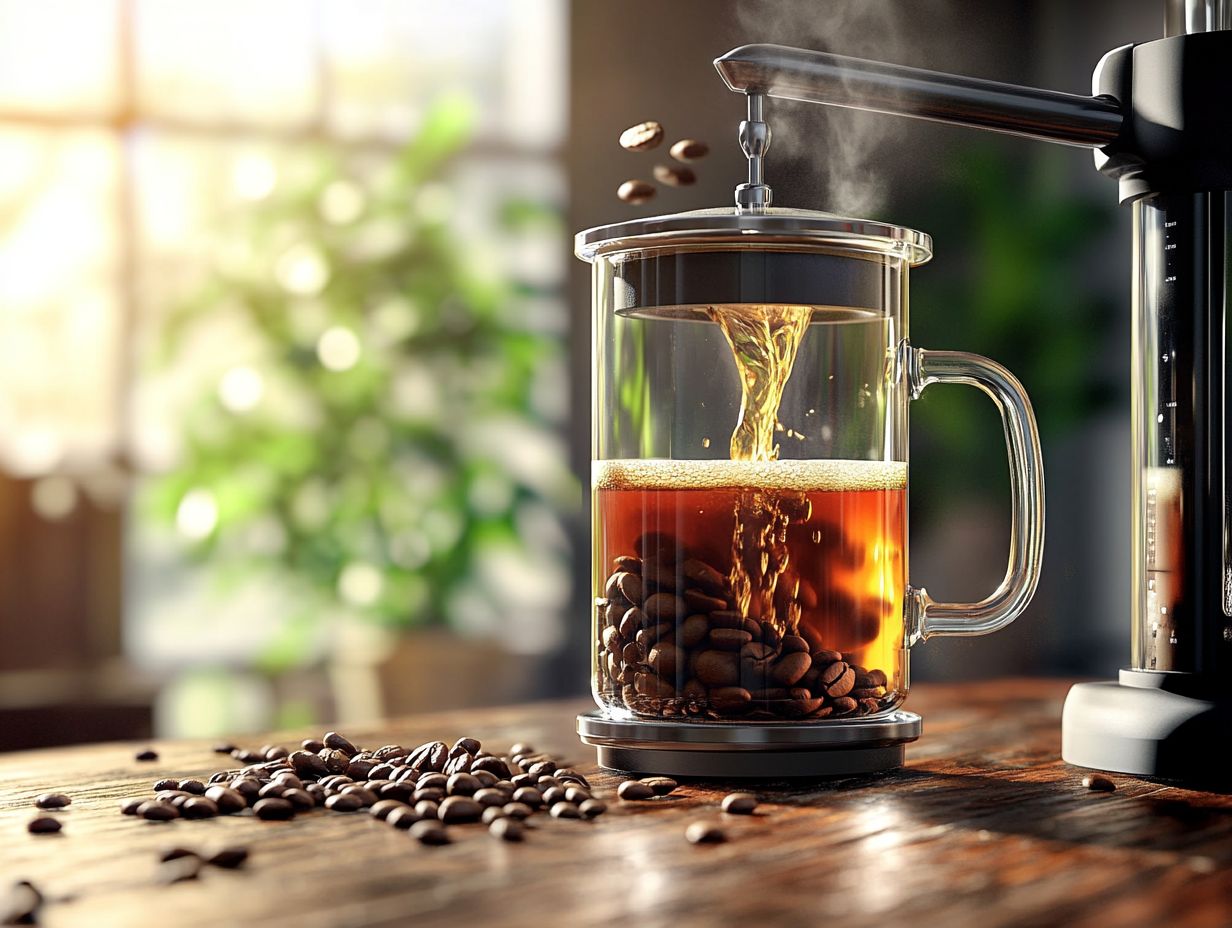
Selecting the right type of coffee beans is essential for elevating your French press coffee experience. The flavor, strength, and overall quality of your brew can differ tremendously based on your choice of coffee.
You might find yourself in a spirited debate between dark roast and light roast beans. Dark roast delivers a bold, rich flavor, while light roast highlights the intricate nuances and acidity of the coffee.
Choosing between whole beans and pre-ground coffee affects the freshness of your brew. It s vital to select beans that align with your personal taste preferences, ensuring a truly satisfying cup every time, whether you’re brewing for yourself or for guests.
In conclusion, using a French press not only enhances the flavor of your coffee but also aligns with sustainable practices. It’s easy to use, easy to clean, and allows you to customize your coffee experience. Try brewing with a French press to discover the full potential of your coffee!
1. Dark Roast vs Light Roast
When you’re choosing coffee beans for your French press, one of the first decisions to consider is whether to opt for a dark roast or a light roast. Each presents its own unique flavor profiles.
This choice can greatly impact the cup you brew. Dark roast beans deliver a bold, rich flavor with pronounced chocolate and smoky notes that cater to those who relish a robust coffee experience.
On the other hand, light roast beans are celebrated for their vibrant acidity and bright, fruity undertones. They are a favored choice for connoisseurs who seek a rich and varied flavor.
The aroma is equally important in your selection process. Dark roasts offer a deep, intense scent, while light roasts bring forth a more floral and citrusy fragrance. This diversity invites you, the coffee lover, to delve into various brewing outcomes and discover your perfect match.
2. Whole Beans vs Ground Beans
The decision to choose between whole beans and ground coffee significantly impacts the freshness and flavor of your French press coffee.
When you grind your coffee beans just before brewing, you unlock a remarkable array of aromatic oils and flavors that are often lost in pre-ground options. This process elevates your brewing experience.
Grinding whole beans guarantees that every sip is packed with maximum freshness and complexity. It allows you to customize grind size, fine-tuning the strength and richness of your brew.
This choice is not just a preference, but a distinct advantage in your coffee routine, supported by the coffee community.
How to Brew Coffee in a French Press
Brewing coffee in a French press is an elegantly simple process that allows you to extract the best flavor and quality with just a few steps.
- Begin by selecting high-quality coffee grounds and measuring the perfect coffee-to-water ratio based on your preferred strength. This is crucial for any coffee brewing method, especially the French press.
- A good rule of thumb is to use approximately 1 ounce of coffee for every 15 ounces of hot water.
- Once you’ve mixed these, pay close attention to the brew time. Let the mixture steep for about four minutes for optimal coffee extraction.
- Then, press the plunger down slowly, separating the grounds from the brewed coffee using the mesh filter.
This method guarantees a delightful coffee experience every time.
Preheat the French Press and Cup
Before you embark on the journey of coffee preparation, take a moment to preheat both your French press and your coffee cup. This essential step ensures that your coffee retains its optimal temperature during extraction.
This straightforward yet impactful practice plays a vital role in enhancing the overall flavor profile of your brew. By warming your tools, you reduce the risk of temperature fluctuations, which can lead to uneven extraction and a lackluster cup of coffee.
Ensuring uniform heat distribution allows the rich oils and aromatic compounds within the coffee beans to shine, resulting in a brew that is both delicious and robust.
Incorporating best practices, such as maintaining the right water-to-coffee ratio and using freshly ground beans, will further elevate your coffee brewing game and help you achieve that perfect cup.
Temperature control is key in crafting coffee that truly delights the palate. Adopting the habit of preheating can lead to remarkable enhancements in every sip.
2. Measure and Grind Your Coffee Beans
Measuring and grinding your coffee beans with precision is essential in the French press brewing process. This significantly influences the flavor and strength of your coffee.
The grind size is crucial for effectively extracting flavors from the coffee grounds. Understanding the properties of each grind size can impact your final brew. A coarse grind, reminiscent of sea salt, enables optimal extraction during the steeping process. This brewing variable is vital for achieving a balanced flavor and preventing over-extraction that can lead to bitterness. The correct grind size is a key aspect of the coffee brewing method.
New to brewing? Start with a coffee-to-water ratio of approximately 1:15, adjusting as needed to suit your taste. By focusing on the consistency of your grind and the correct proportions, you can craft a rich, aromatic cup of coffee that showcases the unique characteristics of your chosen beans. This attention to detail separates coffee enthusiasts from casual coffee drinkers.
3. Add Hot Water and Let It Bloom
After grinding your coffee beans to perfection, add hot water to the coffee grounds in your French press and allow them to bloom for a brief moment. Blooming is the release of gases from coffee grounds when hot water is added.
This initial blooming phase is essential in most brewing techniques. It activates the coffee’s rich flavors and enticing aromas while releasing carbon dioxide trapped during roasting. As the hot water mingles with the grounds, they swell and expand, breaking down their cellular structure and facilitating full immersion. This ensures that the extraction of flavors reaches its full potential.
Don t skip this crucial step! Skipping it could lead to a disappointing cup where the complex notes of the beans are drowned out by bitterness. Blooming not only enhances flavor but also plays a significant role in achieving a smoother, richer final brew.
4. Stir and Let It Steep

Once you’ve added hot water and let the coffee grounds bloom, gently stir the mixture. This step is essential for ensuring even saturation before steeping for the recommended brew time. Proper stirring techniques are part of mastering French press techniques.
That stirring isn t just a casual gesture; it s key to breaking up clumps of coffee that could impede water penetration, leading to uneven extraction. The steeping time becomes crucial, as it directly shapes the flavor profile of your coffee. A longer steep means fuller extraction, resulting in a rich and complex taste, while a shorter steep will give you a milder brew.
Understanding the relationship between these two steps is vital for crafting that perfect cup. The right balance of time allows for an optimal fusion of aromatic compounds, enhancing your overall drinking experience.
5. Press and Pour
After steeping your coffee, it’s time to press down the plunger slowly and steadily, separating the brewed coffee from the grounds before pouring that liquid gold into your cup. This is a hallmark of French press techniques.
To achieve the best results, apply even pressure while pressing down the plunger. This technique ensures an efficient separation of the liquid from the sediment while preserving the rich flavors you’ve created.
When you re ready to pour, tilt the French press slightly and use a gentle, controlled motion. This allows the brewed coffee to flow smoothly into your cup, minimizing the risk of pesky fine coffee particles sneaking in.
By following this method, you ll enjoy a cleaner, more satisfying cup of coffee, letting the full range of flavors truly shine through.
Tips for Getting the Best Cup of French Press Coffee
To craft the perfect cup of French press coffee, embrace a few essential tips that will elevate your brewing experience and enhance your overall enjoyment of this delicious drink. These tips are especially useful for coffee lovers.
Try these tips today and enjoy the rich flavors of your French press coffee!
Essential Tips for Brewing French Press Coffee
1. Use Freshly Roasted Beans
Using freshly roasted beans is one of the most critical factors in brewing exceptional French press coffee. Freshness significantly impacts flavor and aroma.
This is one of the coffee brewing tips all enthusiasts should follow. This is a common practice in coffee culture.
When you choose freshly roasted coffee beans, you release the oils that make your coffee rich and flavorful. Over time, even the highest quality beans can lose their character and complexity, leading to an undesirable, stale taste that no one wants in their coffee.
Selecting beans sourced from reliable roasters not only guarantees optimal freshness but also reveals a delightful range of flavors, from fruity and floral notes to deep, chocolatey undertones. This choice is often recommended in any coffee brewing guide.
By prioritizing the use of freshly roasted beans, you ll elevate your coffee experience to new heights, savoring each sip as a celebration of skillfully sourced and expertly prepared coffee.
2. Experiment with Ratios and Brewing Time
Experimenting with different coffee-to-water ratios and brew times gives you the power to craft your French press coffee to perfection, tailored precisely to your taste preferences. This is a key aspect of coffee brewing tips.
By tweaking these brewing variables, you can unlock a spectrum of unique flavor profiles, from bold and robust to light and delicate.
This makes every cup a part of the coffee enjoyment process. These adjustments also cater to different coffee varieties. For instance, when you increase the coffee dosage, you can intensify the richness of your brew, while extending the brew time might reveal those subtle nuances that make each cup a masterpiece.
It s truly fascinating how even the tiniest adjustments in measurement and timing can dramatically transform the final cup, inviting you to delve deeper into the art of coffee making. This exploration is a significant part of coffee science.
Sharing these brewing discoveries fosters a sense of community among fellow coffee lovers, as you all exchange tips and tricks that lead to delightful tasting experiences. It brings together the coffee community.
With each cup, you create a personal canvas for expressive enjoyment, making the exploration of diverse brewing techniques not just a task but a truly rewarding adventure.
3. Don’t Press Too Hard
When you press down the French press plunger, it s essential to avoid applying too much pressure; doing so can lead to bitter flavors and the over-extraction of the coffee grounds.
By applying just the right amount of pressure during this process, you not only achieve a smoother extraction but also preserve the delicate flavors of the coffee, enhancing your coffee enjoyment.
If you press too aggressively, you risk pushing fines the tiny bits from the coffee grounds through the mesh filter, resulting in an unwelcome gritty texture in your cup.
Aim for gentle, steady pressure to maintain balance among various flavor notes, allowing the natural oils and essences to shine through. This balance is key to the best coffee satisfaction.
For optimal results, don’t hesitate to experiment with brew time and grind size; these factors are intricately linked to your pressing technique and can significantly elevate your overall coffee experience.
4. Clean Your French Press Properly
Properly cleaning your French press after each use is essential for maintaining the quality of your coffee. It also ensures the longevity of your brewing tool. Clean tools are critical for any coffee shop or home brewing setup.
Don’t skip cleaning your French press! This step is crucial for a great cup of coffee. Neglecting this vital step can lead to an unwelcome buildup of coffee oils and grounds, which affects the taste of your brew and can damage the press itself over time.
To get started, pour out any remaining coffee and take apart the plunger to thoroughly access all parts. Next, rinse the carafe with warm water to help loosen any stubborn residue. This step is particularly important for maintaining coffee quality.
For a more thorough clean, grab a soft sponge and a bit of mild detergent. Pay special attention to the mesh filter, where oils tend to accumulate. After handwashing, rinse everything well under warm water to eliminate any soap traces.
Allow all parts to air dry completely before reassembling. This prevents any moisture buildup that could lead to mold. Proper drying is part of maintaining the best coffee tools.
By giving regular attention to these details, you ll ensure your French press continues to brew delicious coffee consistently. Start cleaning your French press now to enjoy your best brew yet!
Frequently Asked Questions for French Press Techniques
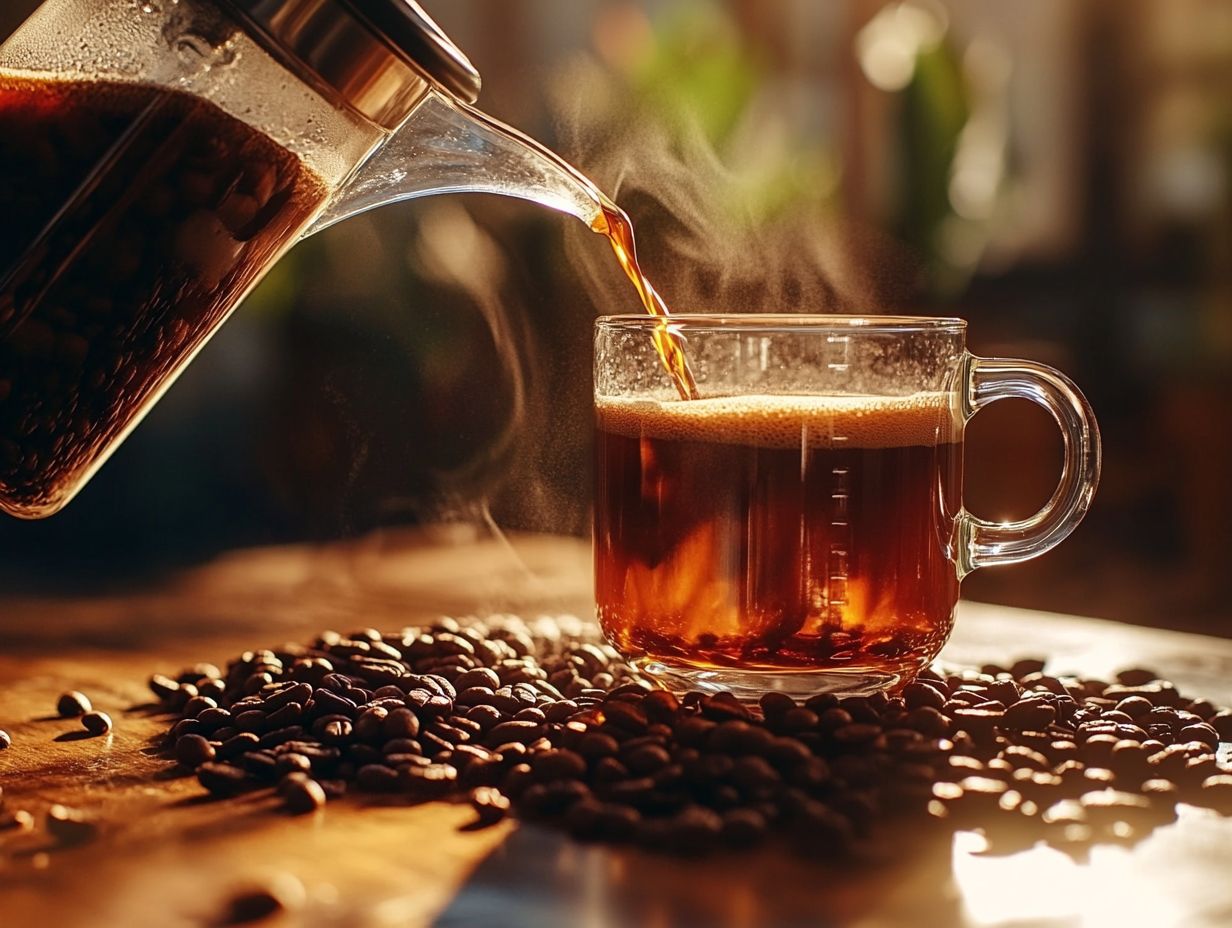
1. Can I use any type of coffee beans in a French press for brewing coffee?
Yes, you can use any type of coffee beans in a French press. However, for the best results, it is recommended to use medium to coarse grind size coffee grounds to avoid clogging the mesh filter and to allow for proper coffee extraction and optimal brewing of flavors.
2. How long should I let the coffee steep in a French press for optimal brewing?
The ideal steeping time for coffee in a French press is 4 minutes. This allows for the perfect balance of coffee flavors and prevents over-extraction, which can result in a bitter taste, enhancing your coffee brewing experience.
3. Do I need to preheat my French press before brewing for better coffee preparation?
Preheating your French press can help maintain the temperature of your coffee during the brewing process. This results in a more flavorful cup.
It is recommended to pour hot water into the empty French press and let it sit for a few minutes before discarding the water and adding your coffee grounds. Many coffee lovers use this technique to enhance flavor.
4. How much coffee should I use in a French press for the best coffee?
The general rule of thumb for the coffee-to-water ratio is to use approximately 1 tablespoon of coffee grounds for every 4 ounces of hot water. However, this can be adjusted based on personal preference for a stronger or weaker cup of coffee.
5. Can I make cold brew in a French press as an alternative brewing method?
Yes, you can make cold brew in a French press. Simply add your desired amount of coffee grounds to the French press and fill it with cold water.
Let it steep in the refrigerator for 12-24 hours before pressing down the plunger and enjoying your cold brew. This cold brew method is a favorite among coffee lovers.
6. How do I clean a French press using proper coffee tools?
Cleaning a French press is easy and can be done in a few simple steps. First, dispose of the used coffee grounds and rinse the press with hot water.
Then, disassemble the parts and wash them with warm soapy water. Rinse thoroughly and let them air dry before reassembling and using it again. Proper cleaning ensures the best coffee flavor and overall coffee satisfaction.

